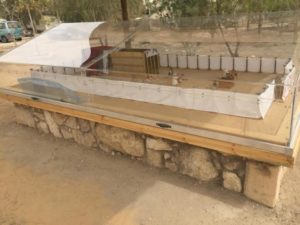
2nd Period of Biblical History
Moses Period
1350 BCE - 1000 BCE
Sponsored By: Available
Four books of the Bible are dedicated to the story of the Jewish exodus from Egypt, their journey through the Sinai wilderness, followed by their entrance into the Promised Land. According to the Book of Numbers, they camped on the outskirts of “Oboth,” which means Tamar or “Palm Tree” in English, before entering Canaan. The springs at Hatzeva provided the abundant waters for the palm trees to grow and this oasis was one of the many stops for the spice caravans, in later years, where they could replenish their water supply.
The Torah has it that Moses received “words from heaven,” saying, “I will give you the Land as a heritage” (Ex. 6:8). This proclamation and similar commandments became priestly teachings for the new inhabitants, instructions informing them how to build God’s Tabernacle and how to live.
Moses was always in the front, leading his people and setting up the newly created Tabernacle at every stop. Finally, the weary wanderers entered the country of Edom, travelled east of the Dead Sea and camped near to present day Amman. There Moses died and Joshua took the leadership of the Israelites before they crossed the Jordan River and entered their Promised Land.
 This is a display of the Tabernacle of Moses. Tabernacle means “tent,” “place of dwelling” or “sanctuary.” It was a sacred place where God chose to meet His people, the Israelites, during the 40 years they wandered in the desert under Moses’ leadership. It was the place where the leaders and people came together to worship and offer sacrifices.
This is a display of the Tabernacle of Moses. Tabernacle means “tent,” “place of dwelling” or “sanctuary.” It was a sacred place where God chose to meet His people, the Israelites, during the 40 years they wandered in the desert under Moses’ leadership. It was the place where the leaders and people came together to worship and offer sacrifices.
Next: Israelite Period
Seven Historic Periods of Israel
Abrahamic Period
2000 - 1350 BCE - learn more
Moses Period
1350 - 1000 BCE - learn more
Israelite Period
1000 - 586 BCE learn more
Greco-Roman Period
586 BCE - 638 CE - learn more
Islamic Period
638 - 1918 CE - learn more
British Period
1918 - 1948 CE - learn more
Israeli Period
1948 - to present - learn more
